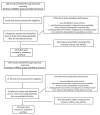The Role of Fatty Acids in Ceramide Pathways and Their Influence on Hypothalamic Regulation of Energy Balance: A Systematic Review
- PMID: 34069652
- PMCID: PMC8160791
- DOI: 10.3390/ijms22105357
The Role of Fatty Acids in Ceramide Pathways and Their Influence on Hypothalamic Regulation of Energy Balance: A Systematic Review
Abstract
Obesity is a global health issue for which no major effective treatments have been well established. High-fat diet consumption is closely related to the development of obesity because it negatively modulates the hypothalamic control of food intake due to metaflammation and lipotoxicity. The use of animal models, such as rodents, in conjunction with in vitro models of hypothalamic cells, can enhance the understanding of hypothalamic functions related to the control of energy balance, thereby providing knowledge about the impact of diet on the hypothalamus, in addition to targets for the development of new drugs that can be used in humans to decrease body weight. Recently, sphingolipids were described as having a lipotoxic effect in peripheral tissues and the central nervous system. Specifically, lipid overload, mainly from long-chain saturated fatty acids, such as palmitate, leads to excessive ceramide levels that can be sensed by the hypothalamus, triggering the dysregulation of energy balance control. However, no systematic review has been undertaken regarding studies of sphingolipids, particularly ceramide and sphingosine-1-phosphate (S1P), the hypothalamus, and obesity. This review confirms that ceramides are associated with hypothalamic dysfunction in response to metaflammation, endoplasmic reticulum (ER) stress, and lipotoxicity, leading to insulin/leptin resistance. However, in contrast to ceramide, S1P appears to be a central satiety factor in the hypothalamus. Thus, our work describes current evidence related to sphingolipids and their role in hypothalamic energy balance control. Hypothetically, the manipulation of sphingolipid levels could be useful in enabling clinicians to treat obesity, particularly by decreasing ceramide levels and the inflammation/endoplasmic reticulum stress induced in response to overfeeding with saturated fatty acids.
Keywords: central nervous system; lipotoxicity; sphingolipids.
Conflict of interest statement
The authors declare no conflict of interest.
Figures


 = high reliability,
= high reliability,  = not clear,
= not clear,  = low reliability.
= low reliability.
 = high reliability,
= high reliability,  = not clear,
= not clear,  = low reliability.
= low reliability.
Similar articles
-
Potential relationship between dietary long-chain saturated fatty acids and hypothalamic dysfunction in obesity.Nutr Rev. 2020 Apr 1;78(4):261-277. doi: 10.1093/nutrit/nuz056. Nutr Rev. 2020. PMID: 31532491 Review.
-
Abnormal saturated fatty acids and sphingolipids metabolism in asthma.Respir Investig. 2024 Jul;62(4):526-530. doi: 10.1016/j.resinv.2024.04.006. Epub 2024 Apr 18. Respir Investig. 2024. PMID: 38640569 Review.
-
Sphingolipids and cancer: ceramide and sphingosine-1-phosphate in the regulation of cell death and drug resistance.Future Oncol. 2010 Oct;6(10):1603-24. doi: 10.2217/fon.10.116. Future Oncol. 2010. PMID: 21062159 Free PMC article. Review.
-
Central ceramide-induced hypothalamic lipotoxicity and ER stress regulate energy balance.Cell Rep. 2014 Oct 9;9(1):366-377. doi: 10.1016/j.celrep.2014.08.057. Epub 2014 Oct 2. Cell Rep. 2014. PMID: 25284795 Free PMC article.
-
Metabolism and biological functions of two phosphorylated sphingolipids, sphingosine 1-phosphate and ceramide 1-phosphate.Prog Lipid Res. 2007 Mar;46(2):126-44. doi: 10.1016/j.plipres.2007.03.001. Epub 2007 Mar 14. Prog Lipid Res. 2007. PMID: 17449104 Review.
Cited by
-
High-Fat Diet-Induced Mitochondrial Dysfunction Promotes Genioglossus Injury - A Potential Mechanism for Obstructive Sleep Apnea with Obesity.Nat Sci Sleep. 2021 Dec 23;13:2203-2219. doi: 10.2147/NSS.S343721. eCollection 2021. Nat Sci Sleep. 2021. PMID: 34992480 Free PMC article.
-
Paraoxonase-like APMAP maintains endoplasmic-reticulum-associated lipid and lipoprotein homeostasis.Dev Cell. 2025 Apr 27:S1534-5807(25)00210-2. doi: 10.1016/j.devcel.2025.04.008. Online ahead of print. Dev Cell. 2025. PMID: 40318637
-
Hypothalamic CREB Regulates the Expression of Pomc-Processing Enzyme Pcsk2.Cells. 2022 Jun 22;11(13):1996. doi: 10.3390/cells11131996. Cells. 2022. PMID: 35805082 Free PMC article.
-
The anti-obesity effects of a water-soluble glucan from Grifola frondosa via the modulation of chronic inflammation.Front Immunol. 2022 Jul 28;13:962341. doi: 10.3389/fimmu.2022.962341. eCollection 2022. Front Immunol. 2022. PMID: 35967316 Free PMC article.
-
Blocking lipid synthesis induces DNA damage in prostate cancer and increases cell death caused by PARP inhibition.Sci Signal. 2024 Apr 9;17(831):eadh1922. doi: 10.1126/scisignal.adh1922. Epub 2024 Apr 9. Sci Signal. 2024. PMID: 38593154 Free PMC article.
References
-
- De Sales-Peres S.H.C., Azevedo-Silva L.J., Bonato R.C.S., Sales-Peres M.D.C., da Pinto A.C.S., Junior J.F.S. Coronavirus (SARS-CoV-2) and the Risk of Obesity for Critically Illness and ICU Admitted: Meta-Analysis of the Epidemiological Evidence. Obes. Res. Clin. Pract. 2020;14:389–397. doi: 10.1016/j.orcp.2020.07.007. - DOI - PMC - PubMed
Publication types
MeSH terms
Substances
Grants and funding
LinkOut - more resources
Full Text Sources

